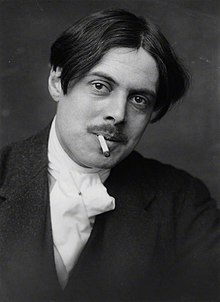Wyndham Lewis



Percy Wyndham Lewis (18 de noviembre de 1882 — 7 de marzo de 1957) fue un pintor y escritor inglés (retiró el nombre 'Percy', que le disgustaba). Fue co-fundador del movimiento artístico llamado Vorticismo, editó la revista literaria de los vorticistas, BLAST, y fue miembro del Camden Town Group. Dentro de su producción narrativa se cuentan Tarr, ambientada en el París previo a la Primera Guerra Mundial y The Human Age, trilogía que comprende The Childermass (1928), Monstre Gai y Malign Fiesta (ambas de 1955), obra ambientada en el tiempo posterior a la guerra. Lewis comenzó un cuarto libro de The Human Age, The Trial of Man, pero abandonó el proyecto en estado fragmentario. También escribió dos volúmenes autobiográficos: Blasting and Bombardiering (1937) y Rude Assignment: A Narrative of my Career up-to-date (1950). Su novela más polémica fue Los monos de Dios (The Apes of God), publicada en 1930, una sátira de los círculos burgueses de Londres que no dejó a nadie indiferente.
Es muy conocida la circunstancia del nacimiento de Lewis, que se produjo en el yate de su padre, frente a la costa canadiense de Nueva Escocia.[1] Su madre inglesa y su padre estadounidense se separaron hacia 1893.[1] Su madre posteriormente regresó a Inglaterra, donde fue educado Wyndham, primero en el Rugby School, y después en el "Slade School of Art", (University College de Londres), antes de dedicarse a viajar por toda Europa y estudiar arte en París.
Referencias
- ↑ a b Richard Cork, ‘Lewis, (Percy) Wyndham (1882-1857)’, Oxford Dictionary of National Biography, Oxford University Press, 2004 (http://www.oxforddnb.com/index/101034517/)
Obras
Traducciones
- Dobles fondos (The Revenge for Love), de Miguel Temprano. Madrid: Alfaguara, 2005.
- Estallidos y bombardeos (Blasting and Bombardiering), de Yolanda Morató. Madrid: Impedimenta, 2008
Estudios
- El Vorticismo. Una victoria pírrica, artículo de Yolanda Morató en ZUT nº 1, 2004.
- Wyndham Lewis The Radical, ed. Carmelo Cunchillos, Peter Lang, 2008.
- Ayers, David. (1992) Wyndham Lewis and Western Man. Basingstoke and London: Macmillan.
- Chaney, Edward (1990) "Wyndham Lewis: The Modernist as Pioneering Anti-Modernist", Modern Painters (Autumn, 1990), III, no. 3, pp. 106-09.
- Edwards, Paul. (2000) Wyndham Lewis, Painter and Writer. New Haven and London: Yale U P.
- Edwards, Paul y Humphreys, Richard (2010) "Wyndham Lewis (1882-1957)". Madrid: Fundación Juan March
- Gasiorek, Andrzej (2004) Wyndham Lewis and Modernism. Tavistock: Northcote House.
- Jameson, Fredric. (1979) Fables of Aggression: Wyndham Lewis, the Modernist as Fascist. Berkeley, Los Angeles and London: University of California Press.
- Kenner, Hugh. (1954) Wyndham Lewis. New York: New Directions.
- Klein, Scott W. (1994) The Fictions of James Joyce and Wyndham Lewis: Monsters of Nature and Design. Cambridge: Cambridge University Press.
- Michel, Walter (1971) Wyndham Lewis: paintings and drawings Berkeley: University of California Press
- Meyers, Jeffrey (1980) The Enemy: A Biography of Wyndham Lewis. London and Henley: Routledge & Keegan Paul.
- O'Keeffe, Paul (2000) Some Sort of Genius: A Biography of Wyndham Lewis. London: Cape.
- Schenker, Daniel. (1992) Wyndham Lewis: Religion and Modernism. Tuscaloosa: U of Alabama Press.
- Villar Flor, Carlos; Domínguez Carballo, Noelia (2007). «Lewisian footprints in Evelyn Waugh's early satires». En Cunchillos Jaime, Carmelo, ed. Wyndham Lewis the Radical. Essays on Literature and Modernity (en inglés). Berlín: Peter Lang. pp. 187-218. ISBN 978-3-03911-200-5.
Enlaces externos
 Wikiquote alberga frases célebres de o sobre Wyndham Lewis.
Wikiquote alberga frases célebres de o sobre Wyndham Lewis.- The Wyndham Lewis Society and Wyndham Lewis Project Website
- Wyndham Lewis's Art Criticism in "The Listener", 1946-51
- Wyndham Lewis en la Fundación Juan March en español
En inglés
- Wyndham Lewis Collection at Carl Kroch Library, Cornell
- Website of the Wyndham Lewis Society
- Wyndham Lewis en la Fundación Juan March en inglés
Lewis' The Tyro: A Review of the Arts of Painting Sculpture and Design, 1921 - 1922
- A recording of Wyndham Lewis reading 'End of Enemy Interlude' from One-Way Song at Harvard in 1940 can be heard on the audio CD Futurism & Dada Reviewed. The same extract can be heard at ubu.com. The full reading can be heard on a cassette issued by Audio Arts.
- The CD, Wyndham Lewis: The Enemy Speaks, includes the One-Way Song recordings and three broadcast talks by Lewis. See [1].
